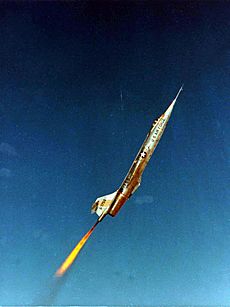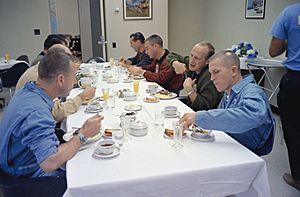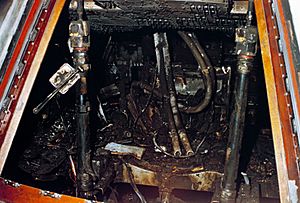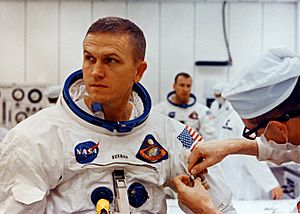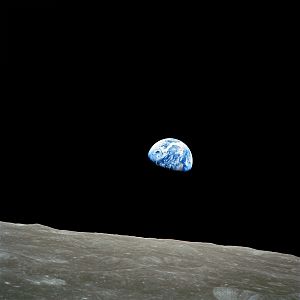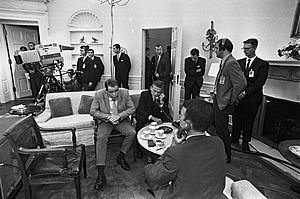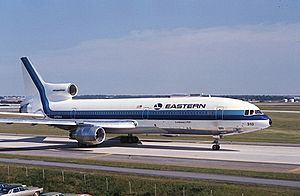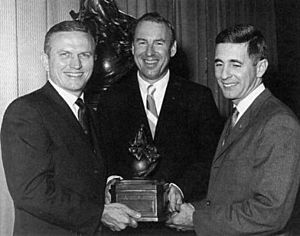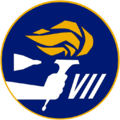Frank Borman facts for kids
Quick facts for kids
Frank Borman
|
|
|---|---|
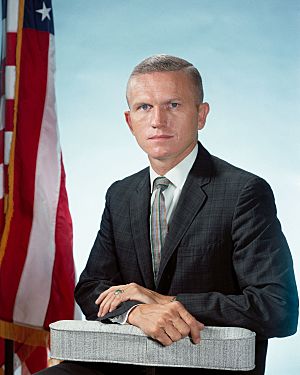
Borman in 1964
|
|
| Born |
Frank Frederick Borman II
March 14, 1928 Gary, Indiana, U.S.
|
| Died | November 7, 2023 (aged 95) Billings, Montana, U.S.
|
| Awards |
|
| Space career | |
| NASA astronaut | |
| Rank | Colonel, USAF |
|
Time in space
|
19d 21h 35m |
| Selection | NASA Group 2 (1962) |
| Missions | Gemini 7 Apollo 8 |
|
Mission insignia
|
|
| Retirement | July 1, 1970 |
Frank Frederick Borman II (born March 14, 1928 – died November 7, 2023) was an American Air Force colonel, engineer, and NASA astronaut. He was also a test pilot and a businessman. He is best known as the commander of Apollo 8. This was the first mission to fly around the Moon. With his crewmates Jim Lovell and William Anders, he became one of the first 24 people to ever do this. For this amazing achievement, he received the Congressional Space Medal of Honor.
Frank Borman graduated from West Point in 1950. He joined the Air Force as a fighter pilot. He later earned a master's degree from Caltech in 1957. After that, he taught at West Point. In 1960, he became a test pilot. He was then chosen for the first class of the Aerospace Research Pilot School. This school trained pilots to become astronauts.
In 1962, NASA selected Borman as an astronaut. He was part of the second group of astronauts, known as the Next Nine. In 1966, he commanded Gemini 7. This mission set a record for staying in space for fourteen days. He also helped investigate the Apollo 1 fire. In December 1968, he flew to the Moon on Apollo 8. This mission is famous for the Earthrise photo. This picture was taken by Bill Anders. It showed Earth rising above the Moon. The crew also read from the Bible on Christmas Eve, which was broadcast on TV. After his space career, Borman worked for Eastern Air Lines. He became its chief executive officer.
Contents
Early Life and Education
Frank Frederick Borman II was born on March 14, 1928. He was born in Gary, Indiana. His father, Edwin Borman, owned a car dealership. His mother was Marjorie Ann Borman. Frank was their only child. His family moved to Tucson, Arizona, because of his health. The warmer climate was better for his sinus problems. Tucson became his hometown.
Frank went to elementary and junior high school in Tucson. He played soccer and baseball. He also had a newspaper route. He then attended Tucson High School. He was a good student. He played football as a quarterback. He also started dating Susan Bugbee, who later became his wife.
During World War II, his parents worked at an aircraft factory. Frank learned to fly at age 15. He took lessons at Gilpin Field. He also joined a flying club. He loved building model airplanes from wood.
Frank wanted to study aeronautical engineering in college. But his parents could not afford an out-of-state university. The local universities did not have strong engineering programs then. He planned to join the Army to get free college tuition.
A friend's father knew Richard F. Harless, a congressman from Arizona. The congressman helped Frank get an appointment to West Point. Frank passed the entrance exam. He entered West Point on July 1, 1946. It was a challenging time. Many students were older and had fought in World War II.
Frank graduated from West Point on June 6, 1950. He was ranked eighth in his class of 670 students. He became a second lieutenant in the United States Air Force (USAF). He married Susan Bugbee on July 20, 1950.
Air Force Career
After his honeymoon, Frank Borman began flight training. He trained in Texas and Arizona. He chose to become a fighter pilot. He was sent to Nellis Air Force Base in Nevada. There, he practiced aerial bombing. His first son, Frederick Pearce, was born in October. Frank received his pilot wings in December 1951.
Soon after, Frank had an ear injury. This prevented him from going to Korea. Instead, he was sent to the Philippines. He was assigned to the 44th Fighter-Bomber Squadron. His ear healed, and he was able to fly again in September 1952. His second son, Edwin Sloan, was born in the Philippines.
Frank returned to the United States. He became a jet flight instructor in Georgia. In 1955, he moved to Luke Air Force Base. He flew many types of jet fighters. In 1956, he was ordered to teach at West Point. First, he needed a master's degree. He earned a Master of Science degree in aeronautical engineering from Caltech in June 1957. He then taught at West Point until 1960. He enjoyed teaching and still flew on weekends.
In June 1960, Borman was chosen for the U.S. Air Force Test Pilot School in California. He became a test pilot. His class included future astronauts Michael Collins and James B. Irwin. After graduating, Borman was accepted into the first class of the Aerospace Research Pilot School. This school prepared test pilots to become astronauts. They learned about orbital mechanics and flew in zero-G aircraft. Borman also introduced training with the Lockheed F-104 Starfighter. This jet would fly very high, then glide down without power. This helped pilots prepare for space.
On April 18, 1962, NASA announced it was looking for new astronauts. The Air Force nominated eleven candidates. Borman was selected as one of the "Next Nine" astronauts. This was announced on September 17, 1962. During his Air Force career, Borman flew 3,600 hours. Most of this time was in jet aircraft.
NASA Career
Frank Borman moved his family to Houston, Texas. This is where the Manned Spacecraft Center (MSC) was being built. Each new astronaut was given a special area to become an expert in. Borman's job was to learn about the Titan II rocket. This rocket was used for Project Gemini missions. He worked with engineers to make sure the rocket was safe.
The astronauts also had classroom lessons. They learned about spacecraft propulsion, orbital mechanics, and astronomy. They also trained for survival in different environments. This included jungle, desert, and water survival. Borman thought some of the training, like geology, was a waste of time. He said, "I didn't care about picking up rocks. I wanted to beat the Soviets to the Moon."
Project Gemini: Long-Duration Flight
NASA planned to test how long astronauts and spacecraft could last in space. This was important for future Moon missions. Frank Borman was assigned as the backup commander for Gemini 4. His co-pilot was Jim Lovell. Then, on July 1, 1965, they were assigned to Gemini 7. This mission was planned to last fourteen days.
Borman and Lovell prepared for the long flight. They jogged daily and played handball to stay fit. Their spacecraft was heavier than previous Gemini crafts. Special plans were made for storing supplies and trash. A new, lighter space suit was also developed for comfort.
A big change happened when the target rocket for Gemini 6 failed. Gemini 6 was supposed to practice meeting another spacecraft in orbit. Borman suggested using Gemini 7 as the target instead. This idea was approved.
Gemini 7 launched on December 6, 1965. Then, Gemini 6 with Wally Schirra and Thomas P. Stafford launched on December 15. Gemini 6 successfully met Gemini 7 in space. The two spacecraft came within 30 centimeters (about 1 foot) of each other. Schirra even held up a sign that said, "Beat Army." This was a joke because Borman was a West Point graduate, while the others were from the Naval Academy.
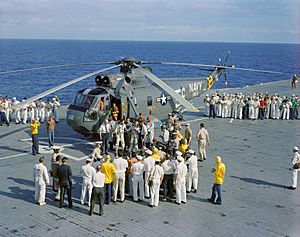
After Gemini 6 returned to Earth, Borman and Lovell stayed in space for three more days. They were in a small space, like the front seat of a car. Finally, on December 18, it was time to come home. The re-entry was perfect. Gemini 7 landed safely near the recovery ship, the aircraft carrier USS Wasp. Borman had never seen an aircraft carrier before and was amazed by its size. For this mission, Borman received the NASA Exceptional Service Medal. He was also promoted to colonel. At 37, he was the youngest full colonel in the Air Force.
Project Apollo: Journey to the Moon
Apollo 1 Fire Investigation
On January 27, 1967, a fire broke out on the Apollo 1 spacecraft. Astronauts Gus Grissom, Ed White, and Roger B. Chaffee were killed. A board was formed to investigate the fire. Frank Borman was the only astronaut chosen to be on this nine-member board. He inspected the burnt spacecraft to find out what happened.
In April 1967, Borman spoke to Congress about the fire. He faced tough questions. But his testimony helped convince Congress that the Apollo program could be made safe again. He told them, "We are trying to tell you that we are confident in our management, and in our engineering and in ourselves. I think the question is really: Are you confident in us?"
After the disaster, Borman went to the North American Aviation plant. This is where the command modules were made. He helped make sure that all the safety recommendations were put into place. He worked to improve the spacecraft's design. A new hatch was designed that allowed astronauts to exit in seconds. This was a big improvement for safety.
Apollo 8: First to Orbit the Moon
Borman's next mission was planned as Apollo 9. It was set for early 1969. But in July 1968, astronaut Michael Collins needed surgery. He was replaced by Jim Lovell. This reunited Borman with his Gemini 7 crewmate.
In August 1968, NASA learned that the Soviet Union might try to fly around the Moon soon. To stay ahead, NASA decided to change Apollo 8. The lunar module (LM) for Apollo 8 was not ready. So, NASA decided to send the Command/Service Module (CSM) to the Moon by itself. This meant Apollo 8 would orbit the Moon without landing. This bold plan would keep the Moon landing on schedule for mid-1969. When Borman was asked if he wanted to command this new mission, he said "yes" right away.
Apollo 8 launched on December 21, 1968. On the second day, Borman felt sick. Researchers now believe he had space adaptation syndrome. This affects some astronauts as their bodies get used to weightlessness.
On December 24, Apollo 8 entered orbit around the Moon. The crew orbited the Moon ten times in twenty hours. The mission is famous for the Earthrise photograph. This picture showed Earth rising above the Moon. It was taken by Bill Anders. The crew also read from the Book of Genesis on Christmas Eve. This was broadcast live on television around the world. Borman had helped plan this special message.
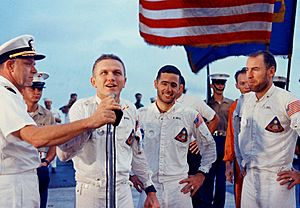
The Apollo 8 spacecraft landed in the ocean on December 27. Borman had wanted a nighttime landing. This meant they didn't have to orbit the Moon as many times. When the spacecraft hit the water, it flipped upside down. Borman quickly inflated bags in the nose, which righted the spacecraft. The crew had to wait 45 minutes for sunrise before they could be rescued. Borman felt seasick. He was happy to be taken aboard the recovery ship, the aircraft carrier USS Yorktown.
Apollo 8 was a huge success at the end of a difficult year, 1968. The crew were the first humans to orbit another celestial body. Many people felt their mission brought hope. Borman received a telegram that simply said, "Thank you Apollo 8. You saved 1968."
The crew received parades in New York, Chicago, and Washington, D.C. They were given the NASA Distinguished Service Medal. Borman also received the Air Force Distinguished Service Medal. He then went on a goodwill tour of Europe. He met with leaders like Queen Elizabeth II and Pope Paul VI.
Apollo 11: Moon Landing Liaison
Frank Borman decided that Apollo 8 would be his last space flight. He planned to retire in 1970. He said his main goal was to help the Apollo Program beat the Russians to the Moon. He did not want to be the first person on the Moon himself.
For the Apollo 11 Moon landing mission in July 1969, Borman worked as NASA's contact with President Richard Nixon at the White House. He watched the launch from the President's office. Borman convinced Nixon to keep his speech to the astronauts short. He also suggested not playing the "Star Spangled Banner" to save the astronauts' time on the Moon. Borman joined the President on the recovery ship, the aircraft carrier USS Hornet, to meet the Apollo 11 crew when they returned.
In June 1970, Borman retired from NASA and the Air Force as a colonel. He said family stress was a big reason for leaving. For his service, he received the Distinguished Flying Cross and the Legion of Merit.
Eastern Air Lines
In 1969, Frank Borman became an advisor to Eastern Air Lines. In 1970, he joined the company full-time. He became its senior vice president for operations. On December 29, 1972, he helped rescue victims of Eastern Air Lines Flight 401. This plane crashed in the Florida Everglades. He waded through the swamp to help survivors.
Borman was promoted to president and chief operating officer in 1975. He became chairman and chief executive officer in 1976. Borman disliked fancy corporate offices and cars. He sold the company jet and drove a second-hand car. He also fired many managers to save money.
Eastern Air Lines had not made a profit since 1969. Borman convinced employees to accept a wage freeze. He also started a program where employees contributed part of their salary. If the company did well, they would get the money back. This helped the company refinance its debt. Profits reached a record high in 1978.
Borman ordered new, fuel-efficient aircraft. But the company's debt grew very large. Also, new rules in 1978 led to many new airlines. Some offered very low prices. This made it hard for Eastern to make money. The company lost a lot of money for several years.
Borman tried to negotiate pay cuts with the unions. Some unions agreed, but others did not. The unions had given up a lot of money over the years. The head of one union said they would only agree if Borman resigned. In response, Eastern's board decided to sell the airline. Borman resigned in June 1986.
Retirement
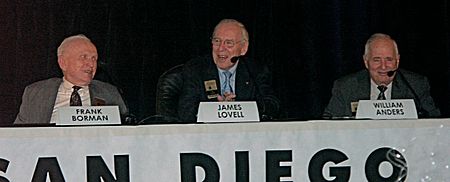
After leaving Eastern Air Lines, Frank Borman and his wife Susan moved to Las Cruces, New Mexico. He owned a Ford car dealership with his son, Fred. He also served on the boards of several companies. In 1996, he published his autobiography, Countdown.
In 1998, Borman bought a cattle ranch in Montana. He raised 4,000 cattle. He also continued his hobbies of rebuilding and modeling airplanes. He rebuilt a rare World War II fighter plane, the Bell P-63 Kingcobra. It won a major award in 1998. He also flew it in airshows. In 1998, he moved to Billings, Montana. His wife Susan suffered from Alzheimer's disease. He spent much of his time caring for her until her death in 2021.
After John Glenn died in 2016, Borman became the oldest living American astronaut. He was eleven days older than his Apollo 8 crewmate, Jim Lovell. Both celebrated their 90th birthdays in March 2018. Borman, Lovell, and Anders reunited for the 50th anniversary of Apollo 8 in December 2018. Borman said he was proud to have flown with them.
Frank Borman died from a stroke on November 7, 2023, at the age of 95.
Awards and Honors
Frank Borman received many awards for his achievements. He and Jim Lovell received the Harmon Trophy twice. First, for their Gemini 7 mission in 1965. Then, again for the Apollo 8 mission in 1968. The Apollo 8 crew also received the Robert J. Collier Trophy for their achievements in space.
Time magazine chose the Apollo 8 crew as its "Men of the Year" for 1968. This recognized them as the people who most influenced events that year. On October 1, 1978, Borman was awarded the Congressional Space Medal of Honor for commanding Apollo 8.
Borman received many other awards. He was given the Academy of Model Aeronautics Distinguished Service Award in 1968. He also received the Golden Plate Award from the American Academy of Achievement in 1969. He was inducted into the International Space Hall of Fame in 1982. In 1982, he was also inducted into the National Aviation Hall of Fame. He was inducted into the United States Astronaut Hall of Fame in 1993.
Tributes
- A part of I-80/I-94 in Lake County, Indiana, is named the Frank Borman Expressway. This runs through his hometown of Gary, Indiana.
- A K–8 school on Davis-Monthan Air Force Base in Tucson, Arizona, is named in Borman's honor.
- A school in Phoenix, Arizona, is named Frank Borman Junior High School.
- A school in Denton, Texas, is named Borman Elementary School.
- A park in Gary, Indiana, is named Borman Square Park.
Images for kids
See also
 In Spanish: Frank Borman para niños
In Spanish: Frank Borman para niños



